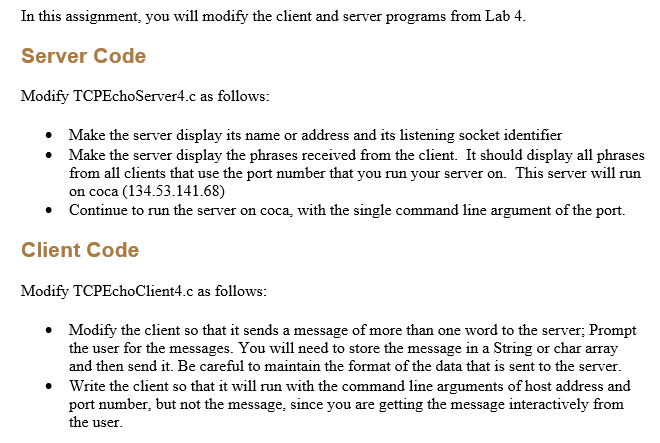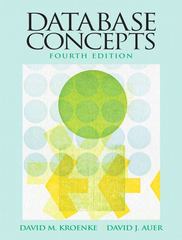Question
Hello, I need help modifying this code with the following instructions: here are the codes: TCPEchoserver4.c #include #include #include #include #include #include #include #include Practical.h
Hello, I need help modifying this code with the following instructions:

here are the codes:
TCPEchoserver4.c
| #include #include #include #include #include #include #include #include "Practical.h"
static const int MAXPENDING = 5; // Maximum outstanding connection requests
int main(int argc, char *argv[]) {
if (argc != 2) // Test for correct number of arguments DieWithUserMessage("Parameter(s)", "
in_port_t servPort = atoi(argv[1]); // First arg: local port
// Create socket for incoming connections int servSock; // Socket descriptor for server if ((servSock = socket(AF_INET, SOCK_STREAM, IPPROTO_TCP)) DieWithSystemMessage("socket() failed");
// Construct local address structure struct sockaddr_in servAddr; // Local address memset(&servAddr, 0, sizeof(servAddr)); // Zero out structure servAddr.sin_family = AF_INET; // IPv4 address family servAddr.sin_addr.s_addr = htonl(INADDR_ANY); // Any incoming interface servAddr.sin_port = htons(servPort); // Local port
// Bind to the local address if (bind(servSock, (struct sockaddr*) &servAddr, sizeof(servAddr)) DieWithSystemMessage("bind() failed");
// Mark the socket so it will listen for incoming connections if (listen(servSock, MAXPENDING) DieWithSystemMessage("listen() failed"); else printf("Listening %s/%d ", inet_ntoa(servAddr.sin_addr), ntohs(servAddr.sin_port));
for (;;) { // Run forever struct sockaddr_in clntAddr; // Client address // Set length of client address structure (in-out parameter) socklen_t clntAddrLen = sizeof(clntAddr);
// Wait for a client to connect int clntSock = accept(servSock, (struct sockaddr *) &clntAddr, &clntAddrLen); if (clntSock DieWithSystemMessage("accept() failed");
// clntSock is connected to a client!
char clntName[INET_ADDRSTRLEN]; // String to contain client address if (inet_ntop(AF_INET, &clntAddr.sin_addr.s_addr, clntName, sizeof(clntName)) != NULL) printf("Handling client %s/%d ", clntName, ntohs(clntAddr.sin_port)); else puts("Unable to get client address");
HandleTCPClient(clntSock); } // NOT REACHED } |
TCPEchoclient4.c
| #include int main(int argc, char *argv[]) { if (argc 4) // Test for correct number of arguments DieWithUserMessage("Parameter(s)", " char *servIP = argv[1]; // First arg: server IP address (dotted quad) char *echoString = argv[2]; // Second arg: string to echo // Third arg (optional): server port (numeric). 7 is well-known echo port in_port_t servPort = (argc == 4) ? atoi(argv[3]) : 7; // Create a reliable, stream socket using TCP int sock = socket(AF_INET, SOCK_STREAM, IPPROTO_TCP); if (sock // Construct the server address structure struct sockaddr_in servAddr; // Server address memset(&servAddr, 0, sizeof(servAddr)); // Zero out structure servAddr.sin_family = AF_INET; // IPv4 address family // Convert address int rtnVal = inet_pton(AF_INET, servIP, &servAddr.sin_addr.s_addr); if (rtnVal == 0) DieWithUserMessage("inet_pton() failed", "invalid address string"); else if (rtnVal // Establish the connection to the echo server if (connect(sock, (struct sockaddr *) &servAddr, sizeof(servAddr)) size_t echoStringLen = strlen(echoString); // Determine input length // Send the string to the server ssize_t numBytes = send(sock, echoString, echoStringLen, 0); if (numBytes // Receive the same string back from the server unsigned int totalBytesRcvd = 0; // Count of total bytes received fputs("Received: ", stdout); // Setup to print the echoed string while (totalBytesRcvd fputc(' ', stdout); // Print a final linefeed close(sock); exit(0); } |
Thank you in advance!
In this assignment, you will modify the client and server programs from Lab 4. Server Code Modify TCPEchoServer4.c as follows: Make the server display its name or address and its listening socket identifier Make the server display the phrases received from the client. It should display all phrases from all clients that use the port number that you run your server on. This server will run on coca (134.53.141.68) Continue to run the server on coca, with the single command line argument of the port. Client Code Modify TCPEchoClient4.c as follows: Modify the client so that it sends a message of more than one word to the server, Prompt the user for the messages. You will need to store the message in a String or char array and then send it. Be careful to maintain the format of the data that is sent to the server. Write the client so that it will run with the command line arguments of host address and port number, but not the message, since you are getting the message interactively from the user In this assignment, you will modify the client and server programs from Lab 4. Server Code Modify TCPEchoServer4.c as follows: Make the server display its name or address and its listening socket identifier Make the server display the phrases received from the client. It should display all phrases from all clients that use the port number that you run your server on. This server will run on coca (134.53.141.68) Continue to run the server on coca, with the single command line argument of the port. Client Code Modify TCPEchoClient4.c as follows: Modify the client so that it sends a message of more than one word to the server, Prompt the user for the messages. You will need to store the message in a String or char array and then send it. Be careful to maintain the format of the data that is sent to the server. Write the client so that it will run with the command line arguments of host address and port number, but not the message, since you are getting the message interactively from the userStep by Step Solution
There are 3 Steps involved in it
Step: 1

Get Instant Access to Expert-Tailored Solutions
See step-by-step solutions with expert insights and AI powered tools for academic success
Step: 2

Step: 3

Ace Your Homework with AI
Get the answers you need in no time with our AI-driven, step-by-step assistance
Get Started


